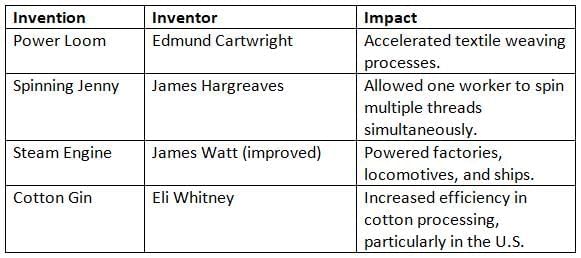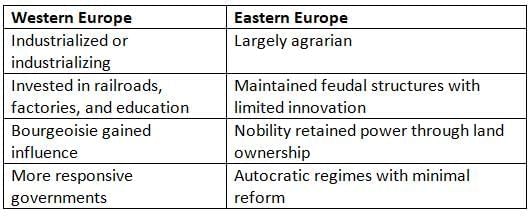The Spread of Industry Throughout Europe Chapter Notes | AP European History - Grade 9 PDF Download
Introduction
Britain’s pioneering role in the Industrial Revolution marked a transformative era in European history, driven by unique economic, political, and social advantages. This chapter notes examines why Britain led industrialization, the emergence of industrial capitalism, and the spread of mechanization across Europe. It also explores the social disruptions, innovations, and agrarian consequences that reshaped societies during this period.
Britain Takes the Lead
The OG Industrialized Country
- Great Britain was the first nation to experience the First Industrial Revolution, thanks to several distinct advantages:
- A robust banking system and well-established financial institutions.
- A supportive constitutional government that fostered economic growth.
- A growing colonial empire that provided resources and markets.
- A surplus labor force resulting from the Agricultural Revolution.
- Abundant natural resources, including coal, iron, and water.
- These factors, combined with Britain’s advanced infrastructure and stable political environment, created the foundation for its industrial leadership. Success came not just from having resources but from leveraging them effectively.
The Role of Capitalism
- In 1776, Adam Smith’s The Wealth of Nations introduced laissez-faire economics, advocating for minimal government intervention and market-driven supply and demand.
- This philosophy provided the ideological backbone for industrial capitalism, encouraging capital investment in new technologies and fueling industrial expansion.
- Conversely, Thomas Malthus’s Theory of Population cautioned that population growth would outpace food production. However, advancements in industry and agriculture contradicted his grim predictions.
- Key Formula: Natural resources + capital + labor = Britain’s industrial surge.
Government Involvement & Infrastructure
- Although private enterprise drove much of industrialization, the British Parliament played a significant role:
- Repealed the Corn Laws to reduce food prices, benefiting workers.
- Promoted infrastructure development, including railroads, canals, and ports.
- Supported scientific advancements and innovation.
- Organized the Great Exhibition of 1851 at the Crystal Palace, showcasing Britain’s industrial and imperial achievements.
- Britain attempted to safeguard its industrial advantage by prohibiting engineers from emigrating and banning the export of machinery blueprints. Despite these efforts, industrial knowledge spread to Europe and beyond.
A Ripple Effect: Industrialization Spreads
France: A Gradual Approach
France followed Britain in industrializing but adopted a more cautious, state-guided approach:
- Integrated small-scale workshops and artisan labor to avoid widespread displacement.
- The government invested in railroads and iron production.
- Industrialization progressed more slowly, minimizing social disruption.
Germany: Late but Explosive
German states industrialized later but saw rapid growth after unification in the late 19th century:
- Prussia developed its railway and mining sectors.
- The Zollverein, a customs union, facilitated tariff-free trade among German states, boosting economic growth.
- By the Second Industrial Revolution, Germany competed with Britain in coal, steel, and chemical production.
Eastern and Southern Europe: Left Behind
Regions like Italy, Austria-Hungary, and Russia remained predominantly agrarian due to:
- Challenging geography, such as mountainous terrain and limited navigable rivers.
- Lack of sufficient capital investment.
- Minimal government initiatives to promote industry.
- Persistent serfdom, which restricted labor mobility.
Urbanization, Disruption, and Resistance
From Cottage to Factory
- As machines replaced manual labor, many farmers and cottage industry workers migrated to cities for factory jobs, resulting in:
- Overcrowded urban housing.
- Unsafe working environments.
- Increased pollution.
- Widespread disease.
- While goods became more affordable, the working class faced significant hardships from these changes.
The Luddite Movement
The Luddites, a group of skilled textile workers, resisted mechanization that displaced their livelihoods. They:
- Destroyed machinery and factory equipment.
- Protested low wages and hazardous working conditions.
Though suppressed, their actions underscored rising class tensions and the human toll of industrial progress.
Industrial Innovations

Agrarian Consequences
The “Hungry 40s”
- Rural Europe faced economic hardship in the 1840s due to:
- Crop failures across the region.
- Food shortages and scarcity.
- Rising food prices and widespread starvation.
- The Irish Potato Famine (1845–1852) was particularly catastrophic:
- Triggered by potato blight.
- Resulted in approximately 1 million deaths.
- Caused mass emigration and fueled resentment toward British governance.
Western vs. Eastern Europe

Conclusion
Industrialization reshaped Europe’s social, economic, and political landscapes. Britain’s leadership, driven by capital and innovation, set a precedent, but the spread of industry highlighted regional disparities. It disrupted traditional lifestyles, created new social classes, and altered power dynamics across the continent. As Europe modernized, tensions emerged—between classes, regions, and the forces of progress and tradition.
Key Terms
- Adam Smith: An 18th-century Scottish economist whose work, The Wealth of Nations, laid the foundation for classical economics, promoting free markets and influencing industrial capitalism.
- Agricultural Revolution: A period from the late 17th to 19th centuries marked by innovations in farming, boosting food production and population, enabling industrialization.
- British Parliament: The UK’s legislative body, consisting of the House of Commons and House of Lords, shaping laws and policies that supported industrial growth.
- Capitalists: Individuals or entities investing in businesses for profit, driving industrial expansion and influencing labor conditions and economic structures.
- Capitalism: An economic system where private entities own production means, fostering competition and innovation, central to industrial growth in Europe.
- Coal: A key energy source during the Industrial Revolution, powering steam engines and factories, driving economic and societal changes.
- Corn Laws: Early 19th-century UK laws imposing tariffs on imported grain to protect local prices, influencing economic and social policies.
- Cotton Gin: Invented by Eli Whitney in 1793, this machine revolutionized cotton processing, boosting efficiency and impacting economies in Europe and the U.S.
- Crystal Palace: A grand structure built for the 1851 Great Exhibition in London, symbolizing industrial achievements and technological progress.
- Edmund Cartwright: English inventor of the 1785 power loom, which automated weaving and boosted textile production during the Industrial Revolution.
- Economic Institutions: Systems like banks and corporations that govern economic activity, facilitating industrial growth and investment in Europe.
- Eli Whitney: American inventor of the 1793 cotton gin, enhancing cotton production and introducing interchangeable parts, influencing industrial processes.
- Enclosure Acts: 18th–19th century UK laws privatizing common lands, contributing to urbanization and industrial labor supply.
- Engineers: Professionals designing and maintaining systems, driving industrial innovation in infrastructure, manufacturing, and transportation.
- First Industrial Revolution: A late 18th-century shift to industrialized economies in Britain, marked by machinery and factories, influencing social and political structures.
- Free Market: An economic system with minimal government intervention, driven by supply and demand, encouraging innovation and industrial growth.
- Great Exhibition: A 1851 London world’s fair showcasing industrial advancements, promoting global trade and technological competition.
- Human Capital: The skills and knowledge of individuals, essential for industrial productivity and economic growth in Europe.
- Hungry 40s: A period of famine and unrest in 1840s Europe, highlighting contrasts between industrial and agrarian regions, spurring social reforms.
- Industrialization: The shift from agrarian to industrial economies, characterized by mass production and factories, reshaping social and economic norms.
- Inventors: Individuals creating new devices or methods, driving technological advancements during industrialization in Europe.
- Iron: A key material in the Industrial Revolution, used in machinery and construction, supporting industrial and economic growth.
- Iron Production: The extraction and processing of iron, critical to industrial advancements in railways, machinery, and construction.
- James Hargreaves: English inventor of the 1760s spinning jenny, revolutionizing textile production by enabling multiple threads to be spun simultaneously.
- Luddites: Early 19th-century English workers who destroyed machinery in protest of job losses, highlighting industrial labor tensions.
- Potato Famine (Great Irish Famine): A 1845–1852 catastrophe caused by potato blight, leading to mass starvation, emigration, and anti-British sentiment in Ireland.
- Power Loom: A mechanized weaving device developed in the early 19th century, increasing textile production efficiency during the Industrial Revolution.
- Serfdom: A medieval system binding peasants to land, restricting labor mobility and hindering industrialization in Eastern Europe.
- Spinning Jenny: Invented by James Hargreaves in 1764, this machine revolutionized textile production by spinning multiple threads at once.
- Steam Engine: A machine converting steam’s heat into mechanical work, powering factories, trains, and ships, central to industrial progress.
- Steel Production: The creation of steel from iron ore, revolutionizing construction and manufacturing with durable materials.
- Textile Production: The process of creating fabrics, pivotal to early industrialization, transforming labor and economic dynamics.
- Theory of Population: A concept examining population growth’s impact on resources, influential during industrialization’s labor and urbanization shifts.
- The Wealth of Nations: Adam Smith’s 1776 text advocating free markets, shaping industrial capitalism and economic policies in Europe.
- Thomas Newcomen: English inventor of an early 18th-century steam engine, enhancing productivity in mining and industry.
- Thomas Malthus: English scholar whose population theories warned of resource shortages, relevant to industrial-era sustainability debates.
- Urbanization: The growth of urban populations driven by industrialization, reshaping social, economic, and cultural dynamics.
- Victorian Era: The period of Queen Victoria’s reign (1837–1901), marked by industrial, cultural, and political changes in Britain and Europe.
- Water: A critical resource during industrialization, powering mills and steam engines, enabling factory development along rivers.
- Wood: A vital material in early industrialization, used in construction and manufacturing before iron and steel became prevalent.
FAQs on The Spread of Industry Throughout Europe Chapter Notes - AP European History - Grade 9
| 1. What were the key factors that allowed Britain to take the lead in the Industrial Revolution? |  |
| 2. How did industrialization impact urbanization in Europe? |  |
| 3. What were some of the major innovations during the Industrial Revolution? |  |
| 4. In what ways did industrialization disrupt traditional agrarian societies in Europe? |  |
| 5. How did the spread of industrialization differ between Western and Eastern Europe? |  |















